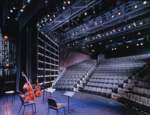United States Post Office–Bronx Central Annex

The Bronx Central Annex of the United States Postal Service is a historic post office building located at 558 Grand Concourse in Concourse, the Bronx, New York, United States. The four-story structure was built from 1935 to 1937. The building was sold in 2014 and is being transformed into retail, postal service, office and restaurant space. The building was listed as a New York City Landmark in 1975 and on the National Register of Historic Places in 1980. Additional city landmark status was granted in 2013 to the interior, which includes a notable series of New Deal-era murals in fresco created in 1939 by Ben Shahn and Bernarda Bryson Shahn for the Treasury Department Art Project's Section of Fine Arts.
Excerpt from the Wikipedia article United States Post Office–Bronx Central Annex (License: CC BY-SA 3.0, Authors, Images).United States Post Office–Bronx Central Annex
Grand Concourse, New York The Bronx
Geographical coordinates (GPS) Address Nearby Places Show on map
Geographical coordinates (GPS)
| Latitude | Longitude |
|---|---|
| N 40.818888888889 ° | E -73.926944444444 ° |
Address
Grand Concourse 558
10451 New York, The Bronx
New York, United States
Open on Google Maps










